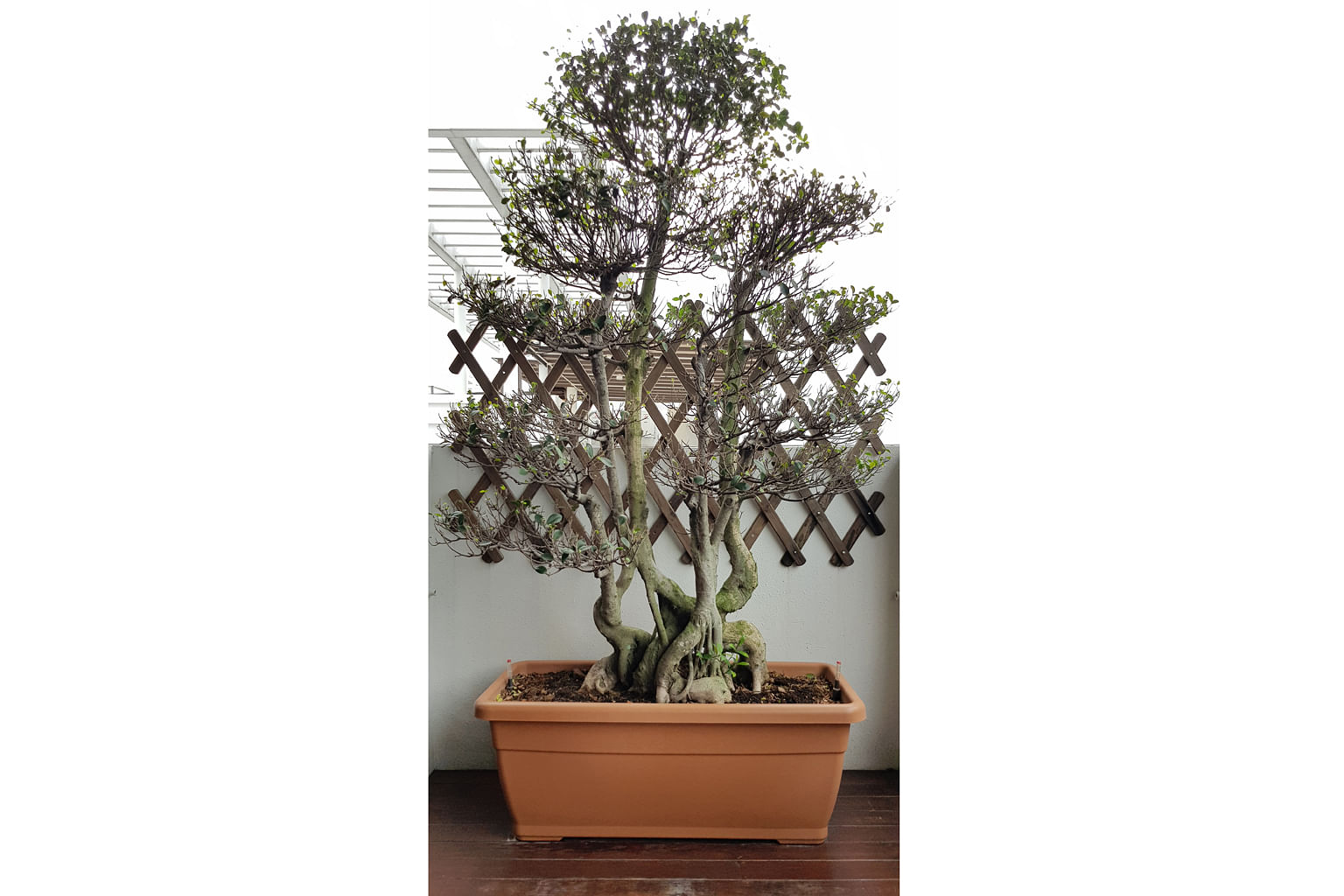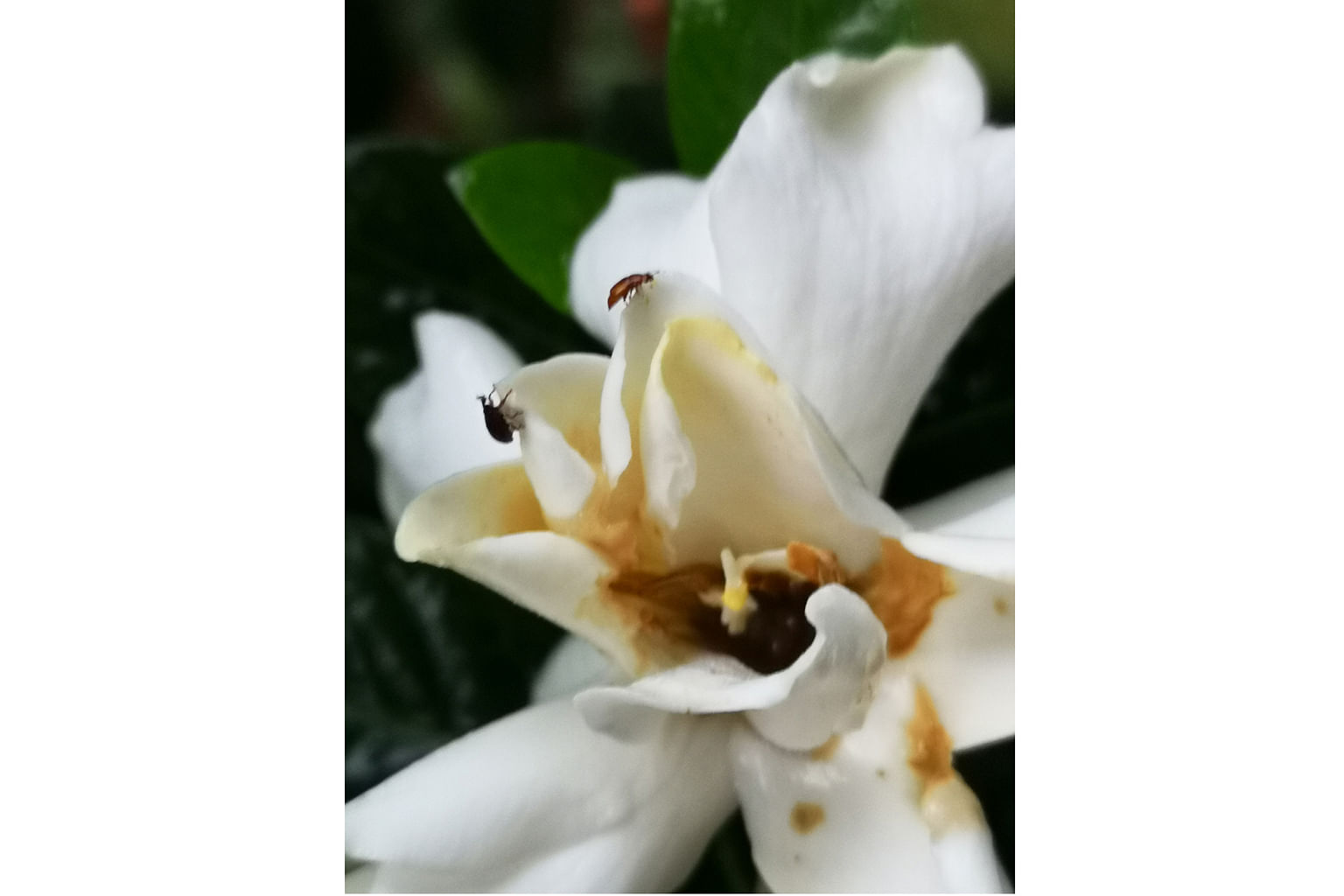Plants infested by caterpillars and virus
My blue pea plants were growing well, but became sick after a year. I then cleared and removed them. Now, there are new plants growing naturally in the same spot from the seeds of previous plants. However, I notice that they are getting sick like the previous plants. There are white spots on the leaves. What happened and what should I do to make them healthy again?
Goh Chew Eng
There are two issues affecting your Butterfly Pea (botanical name - Clitoria ternatea).
The picture on the left (above left) shows folded portions of a leaf that have dried up - this is caused by leaf-rolling caterpillars.
Affected leaves will not recover and these can be pruned for aesthetic reasons.
The attack occurs seasonally and generally does not affect the plant's health drastically. Although it is not always practical, a physical barrier like a fine mesh can be used to cover the entire plant to prevent adult moths from laying eggs on the plant. Selective pesticides like Dipel (based on Bacillus thuringiensis subsp. kurstaki) may also be applied onto plants as a preventive pesticide.
The picture on the right (above right) shows mottling on the leaves and this is likely caused by a virus. Not much is known about the transmission method of this virus, but affected plants do not seem to be adversely affected.
There is no cure for viral diseases in plants and if the appearance of the plant is a bother, you may want to remove and discard the plant.
Sterilise all cutting tools after pruning affected plants to avoid spreading the disease to other vulnerable plants.
Ficus bonsai's root system may be damaged

My plant (above) had plenty of green, healthy-looking leaves about 1.5 years ago. Now, it has few or no leaves. The main branch and stem have also shrunk.
I was advised to water it only once a day, but the condition continues to deteriorate. I give the plant a little fertiliser every two weeks as advised. What can I do to save it?
Dave Kok
There are three main reasons for the decline of your Ficus bonsai.
First, it may be suffering from a root issue where water uptake is hindered, leading to the decline of the aerial parts of the plant.
Was the plant transplanted properly from the nursery into the container? Any major roots that have grown into the ground but got cut away during the transportation can lead to shock.
The plant may or may not be able to produce new roots. When water cannot be transported from the roots to the rest of the plant, the aerial parts will dry and die away.
To check if the shrunken, aerial parts are alive, you need to see if they are dry and brittle or green and pliable. If they are dry and brittle, those portions have died and you will need to prune to the healthy portions of the branch to promote new growth.
Another reason could be underwatering. The watering regimen given by the nursery serves as a guide. It will vary according to the growing environment.
As a bonsai, there is very little soil in the pot to hold water for the plant. Watering may need to be increased if the plant is being grown in a hot and windy area. If the plant is allowed to dry out for long periods, leaves will be shed and aerial parts will dieback.
It appears that this plant is grown in a rather open area, probably a rooftop garden. Note that this plant is probably not suited for growing in a place that is constantly windy as it will dry out quickly, leading to the symptoms described.
It should be placed in a location that is sunny and not too windy.
Finally, you may want to approach bonsai growing societies in Singapore to see if they have members who can help look at the plant and suggest ideas to revive it.
Natal Plum may be pot-bound

What is the name of this plant (above)? The leaves keep turning brown and dropping off, but the stems continue to grow. I bought the plant two to three years ago and I changed the soil once. What is wrong with it?
Chong Nyun Kee
The plant is likely a Natal Plum, which is botanically known as Carissa grandiflora. It produces fragrant white flowers followed by pink, edible fruit. The fruit is reported to be juicy, but has milky sap.
The plant appears to be pot-bound, where its roots have filled the pot. The loss of leaves from older parts of the plant could be a sign that the plant has been allowed to dry out previously. As such, you may want to move it to a larger pot with fresh potting media. Ensure the root zone is kept moist at all times.
The Natal Plum is a sun-loving plant and it is best to grow it in a location with at least four hours of direct sunlight for healthy growth.
After moving the plant to a larger pot, you can prune the plant gradually to promote branching for a more attractive, bushy growth habit.
Gardenia flowers likely damaged by rain

When the flower (above) of my gardenia blooms, the centre turns brown. On closer examination, I find black and brown pests. I check other buds that are about to bloom and find the same pests. What has happened to the flower buds and what are those pests? What can I do to prevent this from occurring again?
Elton Wong
The small creatures appear to be small beetles and they are not reported to be pests that damage the flowers of the gardenia.
Instead, you may want to check if the plant was flowering during the wet season as it tends to do so during cooler weather. The flowers, as a consequence, tend to be damaged by heavy rain and later show symptoms similar to those pictured.
If your plant is a potted specimen, you may want to move it under shelter during the rainy season to protect the flowers. For plants grown in the ground outdoors, you will probably need to build a rain shelter with a clear plastic roof for the same purpose.
Vertical garden may have water, nutrient and pest issues

I am growing three plants in my vertical garden (above) - passion fruit, Clerodendrum thomsoniae and one more with blue flowers, but I do not know its name.
After applying fertiliser for the first time, the plants bloomed. But in the last three to five months, leaves on the first two plants turned yellow and the ones on the last one died.
Two weeks ago, I sprayed them with anti-fungal powder and added soil and put them in bigger pots.
I have also added fertiliser twice a month. There is little improvement to the situation. My balcony does not get direct sunlight. What should I do?
Mitre Krajoski
It appears that your plants may be suffering from water and nutrient issues resulting from an undersized planting trough. In general, climbing plants require a large container to grow in.
For the list of plants you provided, you may need to grow each plant in pots that are at least 30cm in diameter and depth. Small, constrained containers will lead to plants suffering from water stress when they dry out.
You may also want to install an automated watering system to ensure plants are given water periodically, especially during hot and dry weather.
The chlorotic leaves of your Bleeding Heart Vine (its botanical name is Clerodendrum thomsoniae) indicate a nutrient deficiency.
It is recommended that you check the soil pH level to ensure it is between 5.5 and 7.0, which is optimal for most plants, so as to ensure nutrients do not get locked up.
The plant with blue flowers is likely the Butterfly Pea (its botanical name is Clitoria ternatea). Its leaves show numerous small yellow dots, a symptom typical of a spider mite infestation, which is common in this plant.
It is advisable to spray the leaves of your plant with water daily to help increase the humidity of the area, a condition which the spider mites dislike. The water will also help to wash away the eggs and pests.
To manage the population, you may want to remove infested leaves and also spray a diluted solution of summer oil, which will suffocate the adults on your plant. Repeated applications are often required.
• Answers by Dr Wilson Wong, an NParks-certified practising horticulturist and park manager. He is the founder of Green Culture Singapore and an adjunct assistant professor (Food Science & Technology) at the National University of Singapore.
• Have a gardening query? E-mail it with clear, high-resolution pictures of at least 1MB, if any, and your full name to stlife@sph.com.sg

